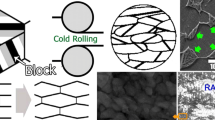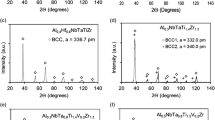Methods of optical and electron microscopy and x-ray spectrum microanalysis are used to study the microstructure and the phase composition of alloy HP40NbTi produced by different casting methods. The effect of melt cooling rate within 1 – 1000 K/sec in the process of crystallization on chemical heterogeneity and quantitative proportion of chromium carbide to niobium carbide in the cast structure is investigated. It is shown that chemical heterogeneity of phases in the alloy is the highest when melt is cooled at a rate of 100 – 300 K/sec, which corresponds to crystallization conditions during welding and surfacing.




Similar content being viewed by others
Notes
Here are subsequently through the text element content, apart from stipulated cases, is given in weight fractions expressed as a %.
References
M. Garbiak, W. Jasinski, and B. Piekarski, “Materials for reformer furnace tubes. History of evolution,” Arch. Foundry Eng., 11(2), 47 – 52 (2011).
S. Borjali, S. R. Allahkaram, and H. Khosravi, “Effects of working temperature and carbon diffusion on the microstructure of high pressure heat-resistant stainless steel tubes used in pyrolysis furnaces during service condition,” Mater. Des., 34, 65 – 73 (2012).
H. M. Tawancy, A. Ul-Hamid, A. I. Mohammed, and N. M. Abbas, “Effect of materials selection and design on the performance of an engineering product — An example from petrochemical industry,” Mater. Des., 28(2), 686 – 703 (2007).
B. Piekarski and J. Kubicki, “Creep-resistant austenitic cast steel,” Arch. Foundry Eng., 8(2), 115 – 120 (2008).
L. H. De Almeida, A. F. Ribeiro, and I. Le May, “Microstructural characterization of modified 25Cr – 35Ni centrifugally cast steel furnace tubes,” Mater. Char., 49(3), 219 – 229 (2003).
E. A. Kenik, P. J. Maziasz, R. W. Swindeman, et al., “Structure and phase stability in cast modified-HP austenite after long-term ageing,” Scr. Mater., 49(2), 117 – 122 (2003).
A. S. Oryshchenko, S. Yu. Kondrat’ev, G. P. Anastasiadi, et al., “Features of structural changes within heat-resistant alloy 0.45C – 26Cr – 33Ni – 2Si – 2Nb at operating temperatures. Communication 1. Cast condition,” Nauch. Techn. Vedom. SPbGTU, No. 1(142), 155 – 163 (2012).
E. A. Kenik, P. J. Maziasz, R. W. Swindeman, et al., “Structure and phase stability in cast modified-HP austenite after long-term ageing,” Scr. Mater., 49(2), 117 – 122 (2003).
A. I. Rudskoy, S. Yu. Kondrat’ev, G. P. Anastasiadi, et al., “Transformation of the structure of refractory alloy 0.45C – 26Cr – 33Ni – 2Si – 2Nb during a long-term high-temperature hold,” Met. Sci. Heat Treat., 55(9 – 10), 517 – 525 (2014).
J. Guo, C. Cheng, H. Li, et al., “Microstructural analysis of Cr35Ni45Nb heat-resistant steel after a five-year service in pyrolysis furnace,” Eng. Fail. Anal., 79, 625 – 633 (2017).
A. S. Oryshchenko, S. Yu. Kondrat’ev, and G. P. Anastasiadi, “Features of structural changes within heat-resistant alloy 0.45C – 26Cr – 33Ni – 2Si – 2Nb at operating temperatures. Communication 2. Effect of high-temperature holding,” Nauch. Techn. Vedom. SPbGTU, No. 1-1(147), 217 – 228 (2012).
A. I. Rudskoy, A. S. Oryshchenko, S. Yu. Kondrat’ev, et al., “Mechanisms and kinetics of phase transformations in refractory alloy 45Kh26N33S2B2 in long-term high-temperature holds. Part 1,” Met. Sci. Heat Treat., 56(1 – 2), 3 – 8 (2014).
A. I. Rudskoy, S. Yu. Kondrat’ev, G. P. Anastasiadi, et al., “Mechanism and kinetics of phase transformations in refractory alloy 45Kh26N33S2B2 under long-term high-temperature holds. Part 2,” Met. Sci. Heat Treat., 56(3 – 4), 124 – 130 (2014).
A. Alvino, D. Lega, F. Giacobbe, et al., “Damage characterization in two reformer heater tubes after nearly 10 years of service at different operative and maintenance conditions,” Eng. Fail. Anal., 17(7 – 8), 1526 – 1541 (2010).
A. I. Rudskoi, G. P. Anastasiadi, A. S. Oryshchenko, et al., “Features of structural changes in heat-resistant alloy 0.45C – 26Cr – 2Si – 2Nb at operating temperatures. Communication. Mechanism and amount of phase transformations,” Nauch.- Tekhn. Ved. SPbGPU, No. 3-2(154), 143 – 150 (2012).
M. P. Dewar and A. P. Gerlich, “Correlation between experimental and calculated phase fractions in aged 20Cr32Ni1Nb austenitic stainless steels containing nitrogen,” Metall. Mater. Trans. A, 44(2), 627 – 639 (2013).
A. I. Rudskoi, G. P. Anastasiadi, S. Yu. Kondrat’ev, et al., “Effect of electron factor (number of electron holes) on kinetics of nucleation, growth, and dissolution of phases during long-term high-temperature holdings of 0.45C – 26Cr – 33Ni – 2Si – 2Nb superalloy,” Phys. Met. Metall., 115(1), 1 – 11 (2014).
S. Y. Kondrat’ev, G. P. Anastasiadi, S. N. Petrov, and A. V. Ptashnik, “Kinetics of the formation of intermetallic phases in HP-type heat-resistant alloys at long-term high-temperature exposure,” Metall. Mater. Trans. A, 48(1), 482 – 492 (2017).
S. Yu. Kondrat’ev, A. V. Ptashnik, G. P. Anastasiadi, and S. N. Petrov, “Analysis of transformations of carbide phases in alloy 25Cr35Ni by the method of quantitative electron microscopy,” Met. Sci. Heat Treat., 57(7 – 8), 402 – 409 (2015).
M. Behúlová, M. Lipták, P. Grga, et al., “Comparison of microstructures developed during solidification of undercooled tool steel in levitation and on a substrate,” J. Phys.: Conf. Ser., 144, Art. 012099 (2009).
P.-F. Paradis, T. Ishikawa, Y. Watanabe, and J. Okada, “Hybrid processing combining electrostatic levitation and laser heating: Application to terrestrial analogues of asteroid materials,” Adv. Opt. Technol., 2011, Art. 454829 (2011).
G P. Anastasiadi, Chemical Microinhomogeneity Formation in Cast Alloys [in Russian], Politekhnika, St. Petersburg (1992)
L. Shen, J. Gong and X. Qin, “Experimental investigation and numerical simulation of carburization layer evolution of Cr25Ni35Nb and Cr35Ni45Nb steel,” Rev. Adv. Mater. Sci., 33, 142 – 147 (2013).
S. J. Rothman, L. J. Nowicki, and G. E. Murch, “Self-diffusion in austenitic Fe – Cr – Ni alloys,” J. Phys. F: Metal Phys., 10(3), 383 – 398 (1980).
G. P. Anastasiadi, R. V. Kolchina, and L. N. Smirnova, “Effect of cooling rate and heat treatment on the chemical micro-inhomogeneity of steel 09Kh16N4BL,” Met. Sci. Heat Treat., 27(9), 678 – 680 (1985).
Author information
Authors and Affiliations
Corresponding author
Additional information
Translated from Metallovedenie i Termicheskaya Obrabotka Metallov, No. 4, pp. 3 – 9, April, 2022.
Rights and permissions
Springer Nature or its licensor holds exclusive rights to this article under a publishing agreement with the author(s) or other rightsholder(s); author self-archiving of the accepted manuscript version of this article is solely governed by the terms of such publishing agreement and applicable law.
About this article
Cite this article
Kondrat’ev, S.Y. Effect of Casting Method on Phase Composition of Heat-Resistant Austenitic Alloys Based on the Fe – 25% Cr – 35% Ni System. Met Sci Heat Treat 64, 191–197 (2022). https://doi.org/10.1007/s11041-022-00783-0
Received:
Published:
Issue Date:
DOI: https://doi.org/10.1007/s11041-022-00783-0




